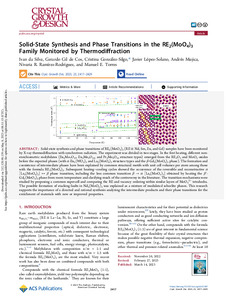Por favor, use este identificador para citar o enlazar este ítem:
http://hdl.handle.net/20.500.11765/14494
Solid-State Synthesis and Phase Transitions in the RE2(MoO4)3 Family Monitored by Thermodiffraction
Registro completo de metadatos
| Campo DC | Valor | Lengua/Idioma |
|---|---|---|
| dc.contributor.author | Silva, Iván da | es_ES |
| dc.contributor.author | Gil de Cos, Gerardo | es_ES |
| dc.contributor.author | González-Silgo, Cristina | es_ES |
| dc.contributor.author | López Solano, Javier | es_ES |
| dc.contributor.author | Mújica Fernaud, Andrés | es_ES |
| dc.contributor.author | Ramírez Rodríguez, Nivaria Rut | es_ES |
| dc.contributor.author | Torres Betancort, Manuel Eulalio | es_ES |
| dc.date.accessioned | 2023-05-08T08:37:44Z | - |
| dc.date.available | 2023-05-08T08:37:44Z | - |
| dc.date.issued | 2023 | - |
| dc.identifier.citation | Crystal Growth and Design. 2023, 23(49), p. 2417–2429 | es_ES |
| dc.identifier.issn | 1528-7483 | - |
| dc.identifier.issn | 1528-7505 | - |
| dc.identifier.uri | http://hdl.handle.net/20.500.11765/14494 | - |
| dc.description.abstract | Solid-state synthesis and phase transitions of RE2(MoO4)3 (RE ≡ Nd, Sm, Eu, and Gd) samples have been monitored by X-ray thermodiffraction with synchrotron radiation. The experiment was divided in two stages. In the first heating, different non-stoichiometric molybdates (Eu4Mo7O27, Eu2Mo4O15, and Pr2Mo4O15 structure types) emerged from the RE2O3 and MoO3 oxides before the expected phases (with α-Eu2(WO4)3 and La2(MoO4)3 structure types and the β-Gd2(MoO4)3 phase). The formation and coexistence of intermediate phases have been explained by common structural motifs with unit cell volumes per atom among those with the formula RE2(MoO4)3. Subsequent heating–cooling cycles showed the occurrence of the reversible and reconstructive α [La2(MoO4)3] ↔ β phase transition, including the less common transition β → α [La2(MoO4)3] obtained by heating the β′-Gd2(MoO4)3 phase from room temperature and clarifying much of the controversy in the literature. The transition mechanisms were studied by proposing a common supercell and comparing the RE and vacancy ordering within similar layers of MoO42– tetrahedra. The possible formation of stacking faults in Nd2(MoO4)3 was explained as a mixture of modulated scheelite phases. This research supports the importance of a directed and rational synthesis analyzing the intermediate products and their phase transitions for the enrichment of materials with new or improved properties. | es_ES |
| dc.description.sponsorship | This work has been partially supported by the Agencia Canaria de Investigación, the Innovación y Sociedad de la Información of Gobierno Autónomo de Canarias (PROID2021010027, PROID202101010, and PROID2020010067), and by Cajacanarias Foundation (from Caixa Bank, Spain) with code 2021ECO5. We also wish to thank the European Synchrotron Radiation Facility (ESRF) organization, in particular, the BM25A beamline. | es_ES |
| dc.language.iso | eng | es_ES |
| dc.publisher | American Chemical Society | es_ES |
| dc.rights | Licencia CC: Reconocimiento CC BY | es_ES |
| dc.subject | Chemical structure | es_ES |
| dc.subject | Crystal structure | es_ES |
| dc.subject | Lanthanides | es_ES |
| dc.subject | Phase transitions | es_ES |
| dc.subject | Oxides | es_ES |
| dc.title | Solid-State Synthesis and Phase Transitions in the RE2(MoO4)3 Family Monitored by Thermodiffraction | es_ES |
| dc.type | info:eu-repo/semantics/article | es_ES |
| dc.relation.publisherversion | https://doi.org/10.1021/acs.cgd.2c01387 | es_ES |
| dc.rights.accessRights | info:eu-repo/semantics/openAccess | es_ES |
| Colecciones: | Artículos científicos 2023-2026 | |
Ficheros en este ítem:
| Fichero | Descripción | Tamaño | Formato | ||
|---|---|---|---|---|---|
| CGD_Silva_2023.pdf | 8,19 MB | Adobe PDF |  Visualizar/Abrir |
Los ítems de Arcimis están protegidos por una Licencia Creative Commons, salvo que se indique lo contrario.





